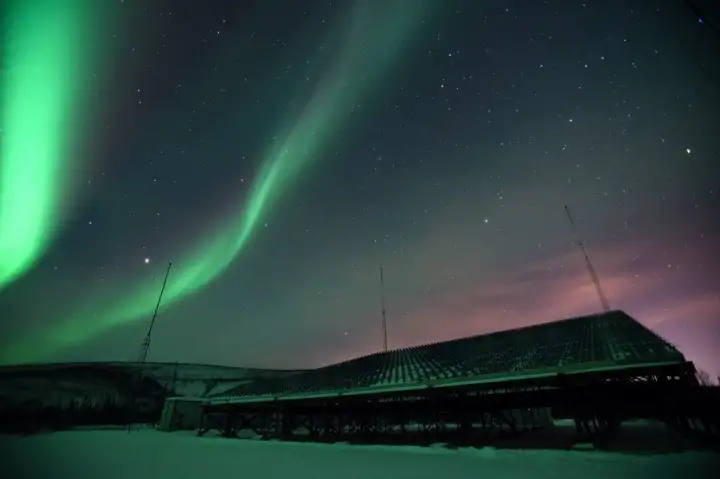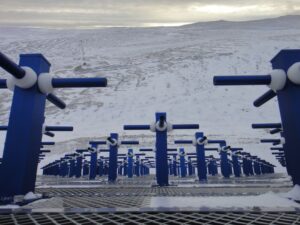AMISR is the first system to provide scientists with the modular, relocatable, and remotely operable technology needed to collect critical data and study the space environment.
The 75 Years of Innovation series highlights the groundbreaking innovations spanning from SRI’s founding in 1946 to today. Each week, SRI will release an innovation, leading up to its 75th anniversary in November of 2021.

AMISR: Generating insights into space weather
The aurora borealis or aurora australis are a natural wonder that people flock to see. Many folk stories have grown up around this phenomenon that talk of dancing spirits and magical beasts. But this amazing show of lights in the sky has a sound scientific reason: our Sun is highly active. The Sun releases charged particles in the form of a “solar wind,’’ and the interactions between the solar wind and the Earth’s magnetic field produces a range of phenomena known as “space weather.” These particles hit atoms and molecules in Earth’s atmosphere causing them to become excited and in doing so, they release photons, aka light.
Space weather doesn’t just create awesome light shows. It can have damaging effects on a multitude of devices, from satellites to airplanes to electric grids.
Being able to predict space weather involved major construction efforts to build large, immovable, Incoherent Scatter Radars (ISR). The development of Advanced Modular Incoherent Scatter Radar (AMISR) made studying space weather more accessible. SRI International developed the first remotely controllable, and relocatable, ISR facility that could be used by research scientists and students across the world.

Why we need the AMISR to measure space weather
It may sound like space weather should not be a concern of us earthlings. However, the phenomenon has a massive impact on our earthly devices and daily activities. Over decades, several space weather-related events have taken place, including in 1989, a massive geomagnetic storm that caused the failure of the Quebec power grid infrastructure. The storm also damaged two transformers in the United Kingdom. A 2017 report by the NOAA National Weather Service on the economic and social impact of space weather in the United States, estimated that the one-time cost of protecting the U.S. power grid against space weather was $50 million to $1 billion.
Space weather is created by solar activity and other more general space-related events. This activity gives rise to three types of space weather:
- Radio blackouts, e.g., solar flares disrupting high-frequency radio.
- Solar radiation storms, flares and Coronal Mass Ejections (CMEs) from the Sun can emit ‘Solar Energetic Particles’ (SEPs). These can adversely affect satellites and aircraft, and SEPs can also cause biological issues with crews of airplanes and astronauts. Satellite electronics affected by solar storms can disrupt transport systems, shipping, and even mobile communications.
- Geomagnetic storms caused by earthward directed CMEs or other structures in the solar wind that interact with the Earth’s magnetic field. These storms can cause power failures in spacecraft and satellites, and some extreme storms can cause communication blackouts or disruptions to power grids.
All three can happen in the same event.
The effects of space weather are on an astronomical scale. This is why the study and observation of space weather events are so important back here on Earth.
The study of space weather is not a new discipline. However, the AMISR project was novel as it created a modular system with a configuration designed to allow an Incoherent Scatter Radar to be relocated to study upper atmospheric activity around the globe. The AMISR systems can also be remotely operated, which has enabled research by many more scientists.
Where does AMISR sit in the history of space weather studies?
Being able to detect and even predict space weather has a long history, but the mid-twentieth century was the era where Incoherent Scatter Radars (ISR), a technique used to observe the ionosphere and upper atmosphere, saw development. ISRs are mainly used in the study of the effects of solar radiation and particles on the Earth’s magnetic field lines. From the mid-1970s the National Science Foundation (NSF) oversaw the development of ISRs.
Back in the day, ISRs were big, fixed, beasts. For example, the Arecibo ISR built in 1962 cost $10 million (around $85 million today) and consisted of a 305-meter fixed dish.
In 2000, SRI International submitted a proposal to build the world’s first, relocatable Atmospheric Observatory. In 2002, this project changed the original scope and became the AMISR, the National Science Board approved funding in 2003, for four years, up to a total of $44 million.
How does AMISR work?
SRI has constructed three full-sized AMISR faces, each with approximately 128 panels covering a 32×28 meter surface. Each panel is made up of 32 Antenna Element Units (AEU) and is controlled by a Panel Control Unit (PCU) for AEU control and monitoring. The radar is powered by eight Utility Distribution Units (UDU), which provide aircraft-standard 400 Hz power. The system is driven from an Operation and Control Center (OCC) that houses general-purpose computers as well as low-level radiofrequency (RF) signal conditioning modules.

The AMISR has been proven over the last 15-years to be very reliable and requires very few on-site staff.
The novelty in the AMISR is that it can be used remotely, and if needed, be relocated. Researchers can operate and position the radar beam, on-the-fly, to measure changing space weather events as they happen. This makes the system highly accessible by students and researchers the world over.
The first radar face of the AMISR was constructed in Poker Flat, Alaska. The remaining two faces were built in Resolute Bay and Nunavut, Canada. Each face of the AMISR is independent, allowing the AMISR to be deployed in up to three separate locations at the same time.
AMISR has found other uses outside of space weather. The Poker Flat ISR was integrated with a cloud-based SaaS platform, by SRI spin-off, LeoLabs, to allow radar data to be used to prevent orbital collisions and detect space debris.
AMISR calming the storm
SRI International took the concept of Incoherent Scatter Radar and made it accessible for a worldwide audience of researchers and students. In doing so, the AMISR has opened up the field of space weather detection. The AMISR facilities have supported over 250 scientific publications covering a diverse range of topics including atmospheric waves, ionospheric disruptions to GPS signals, and plasma instabilities in the aurora.
The AMISR was the first NSF-funded radar system of its size developed for scientific research. This flexible, modular, and accessible radar gives scientists the ability to experiment. This enablement of ‘blue sky’ research opens up opportunities to explore how space weather affects the earth now and into the future.
The next time you see the aurora borealis, the AMISR might be looking at it too.
Note: This material is based upon work supported by the National Science Foundation under Cooperative Agreement No. AGS-1840962. Any opinions, findings and conclusions or recommendations expressed in this material are those of the author(s) and do not necessarily reflect the views of the National Science Foundation.
Resources
AMISR website: https://amisr.com/
Scientific American, “20 Years Ago, Earth Was Blasted with a Massive Plume of Solar Plasma” March 2009: https://www.scientificamerican.com/article/geomagnetic-storm-march-13-1989-extreme-space-weather/
The European Space Agency, Space Weather Effects: https://www.esa.int/ESA_Multimedia/Images/2018/01/Space_weather_effects
NOAA, Social and Economic Impacts of Space Weather in the United States, 2017: https://www.weather.gov/media/news/SpaceWeatherEconomicImpactsReportOct-2017.pdf
Cárdenas, Freddy & Sánchez, Sergio & Vargas Dominguez, Santiago. (2015). The Grand Aurorae Borealis Seen in Colombia in 1859. Advances in Space Research. 10.1016/j.asr.2015.08.026.
Williams, D. (1961), SUNSPOT CYCLE CORRELATIONS. Annals of the New York Academy of Sciences, 95: 78–88. doi:10.1111/j.1749–6632.1961.tb50027.x
LeoLabs: https://www.leolabs.space/
Nicolls, M., SRI International, Space Debris Measurements using the Advanced Modular Incoherent Scatter Radar: https://amostech.com/TechnicalPapers/2015/Poster/Nicolls.pdf
National Science Board funding notice for AMISR: https://www.nsf.gov/od/lpa/news/03/ma0331.htm
Science Daily, Findings From New Upper Atmospheric Radar System For Scientific Research, 2009: https://www.sciencedaily.com/releases/2009/06/090602092253.htm



